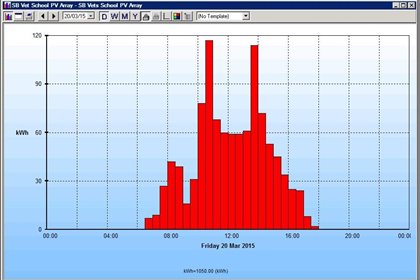September 2014 saw the installation of 1000m2 solar array on the roof of the School of Veterinary Medicine and Science Building at Sutton Bonington. This renewable energy installation has now been operational for seven months and generating solar electricity, which is used within the building and throughout the Sutton Bonington Campus through the High Voltage network. The University’s energy usage is monitored closely through local metering points and this data analysed.

During the recent partial eclipse on 20 March 2015, the effect of the moon obscuring much of the sun can be seen in the electricity generated by the photovoltaic cells. The electricity generated dropped from 39 kWh between 8:30am and 9:00am to 16 kWh generated between 9:00am and 9:30am, the time of the partial eclipse, a drop of 58.9%. The graph clearly shows the drop during this 30 minute period, the electricity generated rising after the event, but also shows the effect of cloud cover later in the day. This reduction of 58.9% was lower than the expected fall in generated electricity nationally, of 75%.
Another "deep" partial eclipse visible in the UK will not occur until 12 August 2026, and the next total eclipse not until September 2090.
Posted on Wednesday 22nd April 2015